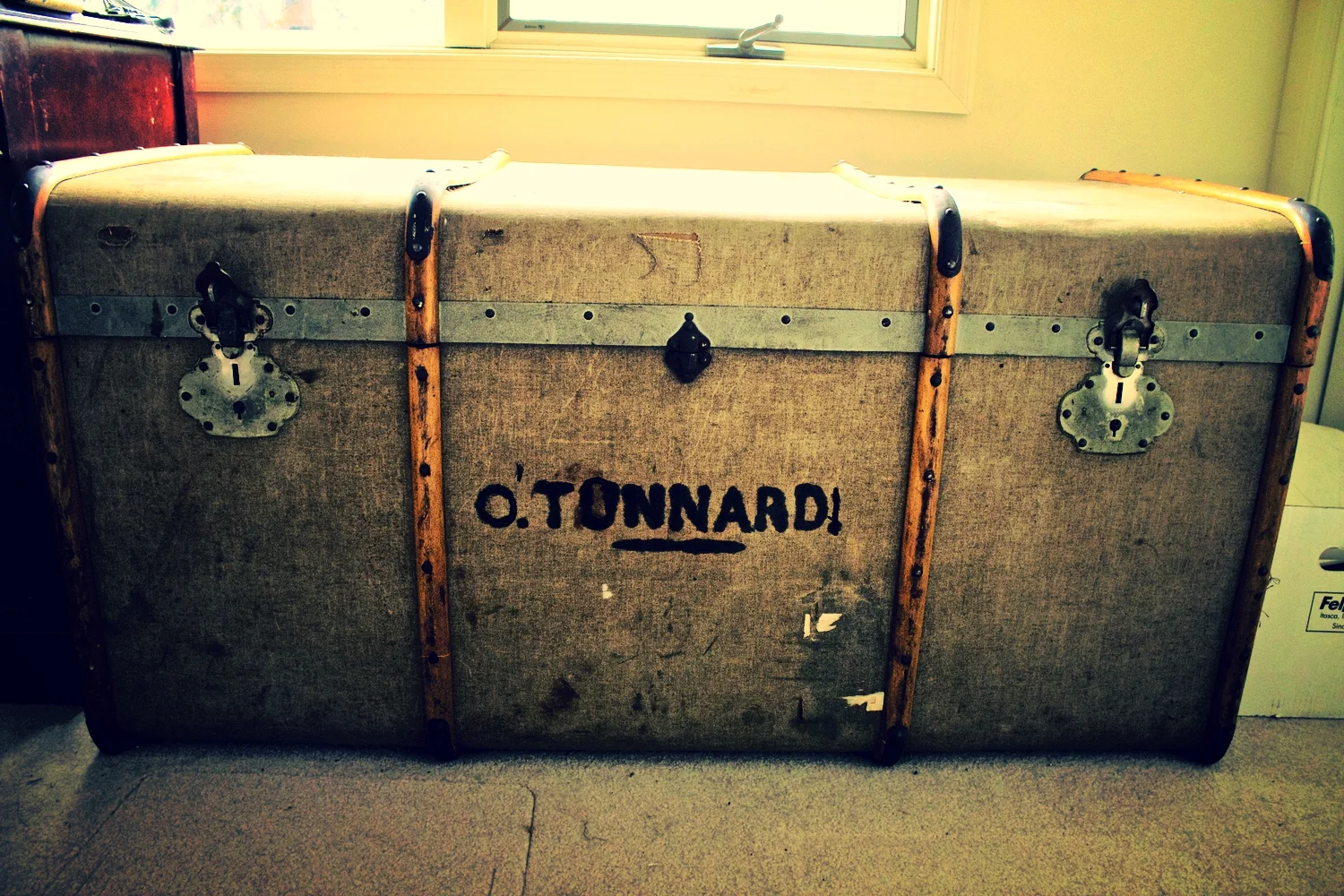Susan Spielvogel was born in New Haven, Connecticut where she attended Hopkins School. She is a graduate of Barnard College/Columbia University where she majored in Art History.
All her life, Ms. Spielvogel had wondered what was inside the trunk which stood in her family's dining room. In 1972, at the age of fifteen, the trunk was opened to reveal its contents. Aspiring to be a writer since the age of four, Ms. Spielvogel was inspired to write the Trunk Trilogy in 2000 when she began to ask her father, Samuel, those hard questions about the fate of the trunk's owner.
By a quirk of history, Ms. Spielvogel's family was split beween America and Austria. While Ms. Spielvogel's father escaped to Ireland and then came to the United States, the remainder of his immediate family escaped to Israel. They returned to Vienna after the War to reclaim the family home and business, the lumberyard located at Beheimgasse 21.
During the summer of 2000, Ms. Spielvogel traveled to Vienna and Antwerp to gather testimony from relatives and research locations associated with her family's past. Using original photographs, documents and letters from her family's archives, Ms. Spielvogel began to write the trilogy. She owes a debt of gratitude to her father, Samuel and to her first cousin Dalia who currently lives in Vienna for her assistance in the research, translations and writing of the Trilogy.
Although Ms. Spielvogel never had the chance to meet Tante Lusia, "the woman of the trunk," ms. Spielvogel was fortunate enough to personally meet and get to know her grandmother, Eva, who lived in Vienna. She was also fortunate enough to be in contact through correspondence with Florence Hobson, the woman from Belfast who had rescued her father in 1939. Miss Hobson remained in constant contact with the family until she passed away in the late 1970s.
Photo taken in 1974 in Vienna. From left, Elsa, Susan, Dalia in front, Sylvia in back.
The Trunk Trilogy reflects on these three powerful women in Ms. Spielvogel's life and introduce them to the reader:
Book I: Seeking A Common Thread- Lusia Spielvogel- Renewal
Seeking A Common Thread takes the reader back and forth in time from Vienna of the 1920s and 1930s where we meet Lusia Spielvogel to Connecticut in 1972 where we meet Susan, a fifteen year old teenager. Susan tries to get to know the "woman of the trunk" through the possessions she had packed away before she fled Vienna in 1939 in anticipation of a future life in freedom, a future that was never to be. Susan discovers a halfway completed embroidered tablecloth among the items in the trunk. A project started, never to be completed by its original owner. The narrative of Seeking A Common Thread interweaves Lusia's story with Susan's completion of the unfinished tablecloth and how through the embroidery to complete the tablecloth, Susan discovers Tante Lusia's story and in turn discovers herself.
Book II: Connecting Threads- Eva Spielvogel- Defiance (release date tba)
The narrative of Connecting Threads goes back and forth in time as the reader follows Susan while she accompanies her father, Samuel, on a trip back to Vienna during the summer of 1972 to visit his mother, Eva. The narrative then goes back in time to 1938 when Eva must choose between fleeing Vienna with her daughter, Elsa, or attempting the unthinkable, trying to free her husband, David, who has been arrested and transported to Dachau. Over the course of the narrative, Susan learns the real fate of her grandfather, David.
Book III: Celtic Knot- Florence Hobson: Hope and Kindness (release date tba)
Celtic knot intertwines the story of Florence Hobson, the Righteous Gentile who rescued Samuel from the Nazis, the story of the refugee camp in Northern Ireland where Samuel stayed along with the children of the Kindertransport and Susan's experiences as she returns to Hopkins School for the Fall semester after her summer trip to Vienna.
Ms. Spielvogel defines herself as a Connecticut Yankee of Austrian descent. She currently resides in the Northeast.
Samuel Spielvogel
Portrait taken circa 1938
Susan's father, Samuel, was born in Sniatyn, Poland on June 13, 1920. Shortly after he was born, his parents moved to Vienna to start a new life. Samuel remained in Sniatyn under the care of Eva's sister, Mali. When Samuel was two years old, he joined his parents in Vienna. Samuel attended the Chajesrealgymnasium, the Jewish high school and was a member of the class of 1938, the last class to graduate before the school closed its doors after the Nazi invasion.
Eva, David, Elsa and Samuel, photograph taken at the photography studio, Vienna, circa 1928. Note the cloche hat and flapper outfit Eva is wearing.
Photograph of Samuel and his sister, Elsa, photography studio at the Prater, Vienna, circa 1930. Note the painted backdrop with the Riesenrad (Ferris Wheel).
Eva Spielvogel
Passport Photo circa 1939
Samuel's mother, Susan's grandmother, Eva (nee Handel) was born in Sniatyn (then part of the Austro-Hungarian Empire) on October 15, 1897. She fled to Israel after the Anschluss and returned to Vienna after the War.
Passport Photo circa 1968
Eva with Elsa and Samuel at a photography studio, at the Prater, Vienna, circa 1936.
Samuel in Ireland circa 1940
Samuel in 2008
Photo of Florence Hobson, circa 1920s
Florence Hobson was a Quaker woman who lived on the outskirts of Belfast, Northern Ireland. She had a chance meeting with Jakob Schrager, a graduate of Chajasrealgymnasium who had left Vienna and gone to Belfast to study medicine. Florence had read in the newspaper about the persecution of the Jews in Austria after the Anschluss and as a woman of conscience decided to do her part to help out. It was necessary for a refugee to be sponsored for a visa by someone in the United Kingdom for a visa in order for them to stay in the country.
Jakob Schrager gave Florence the name and address of Herr Kellner, the director of Chajasrealgymnasium so that she might write him to offer sponsorship for a visa for one of the students. Herr Kellner came to the classroom of the graduating class and read them the letter asking if anyone wanted to take Miss Hobson up on her offer. Of all the students, Samuel was the only one to raise his hand to volunteer to go to Ireland.
A letter from Florence to the author dated 1957
November 19, 1957
Carnalea, County Down, Ireland
Dear Susan,
I have a very bad conscience about you and this silver spoon that has been laid aside for you and every day for the past year I've reminded myself that I should write the accompanying letter. That has kept me thinking of you incessantly and now you are one years old. If I don't hurry up now you will be grown up and I past writing at all.
I wish you could see my very beautiful cream coloured golden retriever Honey by name and nature. She has never had a fight or quarrel in her life and is now nearly four years old.
Thank your daddy for his letter which I was glad and to hear you are well. His letter eased my conscience a little.
This is about all at the moment and tomorrow I shall feel a stone lighter having written at last!
With love to you all, Florence


